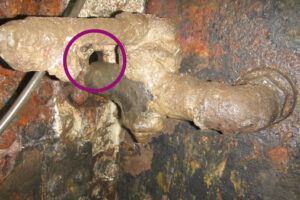(Charleston, SC) – Today scientists will remove the rear hatch cover from the Hunley, the world’s first successful combat submarine. Taking off the hatch is a necessary step in the painstaking conservation process being conducted by an international team of experts at the Warren Lasch Conservation Center in North Charleston, South Carolina.
Archaeologists are hopeful the removal of the rear hatch cover will reveal new insights into why the submarine vanished after it sank the USS Housatonic in 1864, a first in maritime history. Once removed, scientists will be able to examine a portion of the submarine that has been nearly inaccessible since it was recovered from the ocean floor in 2000.
The Hunley has two hatches, forward and aft, which were the only portals crewmembers could use to enter and exit the vessel. Earlier this year, scientists discovered Hunley Captain George Dixon may have unlocked the forward hatch, which could indicate the crew attempted to escape before they perished. However, the lock on the aft hatch appears to have been left in place, completely blocking the exit for crewmembers who were seated in the back of the submarine.
“If the crew thought their life was in danger, surely both hatches would have been unlocked in an effort to escape. This apparent contradiction further complicates an already complex puzzle,” said Senator Glenn McConnell, Chairman of the Hunley Commission.
The positions of the glass viewing ports in the submarine have created special problems for conservators. The chemicals needed to conserve the submarine’s iron hull will damage glass. Therefore all glass parts must be carefully removed.
The aft hatch cover holds the last remaining glass view port on the Hunley. Most of the glass viewing ports were installed from the outside of the submarine and therefore easily accessed. However, the glass port in the aft hatch is unique because it appears to have been mounted from the other side. “That’s why we must first dismantle the aft hatch cover so we can take it into the lab and remove the glass safely,” Hunley Senior Conservator Paul Mardikian said. “The conning tower’s narrow confines have completely blocked access for our work.”
Removing the hatch cover will be a delicate process. During the 136 years the Hunley rested on the ocean floor, silt and shell fragments carried by water currents whipped around the hatch and acted like sandpaper against the iron, slowly and smoothly rubbing away its surface. The abrasions can be clearly seen on the joint holding the hatch cover in place, making it difficult for conservators to dismantle the hinge.
Once the work is completed, scientists will be able to study the locking mechanism mounted to the hatch. “At this point, it appears highly unlikely that the aft hatch is in an unlocked position,” said Hunley Archaeologist James Hunter. “But having better access to examine this portion of the submarine will allow us to confirm that assessment and better understand how the lock actually worked.”
There are several reasons Dixon may have opened the forward hatch in the normal course of his duties as captain of the submarine. For example, he may have opened it for navigational purposes. But the only reason to open the aft hatch during the Hunley’s voyage would have been for emergency escape or to replenish air supply for the crew compartment.
If scientists find no evidence of an attempt to unlock the rear hatch, that fact would suggest the crew did not believe their lives were in immediate danger or, for some other reason, were unable to unlock the hatch. “These are among many mysteries we hope to solve during the course of this historic journey of discovery,” McConnell said.
Friends of the Hunley
On the evening of February 17, 1864, the H. L. Hunley became the world’s first successful combat submarine by sinking the USS Housatonic. After signaling to shore the mission had been accomplished, the submarine and her crew of eight vanished. Lost at sea for over a century, the Hunley was located in 1995 by Clive Cussler’s National Underwater and Marine Agency (NUMA). The hand-cranked vessel was raised in 2000 and delivered to the Warren Lasch Conservation Center, where an international team of scientists are at work conserving the vessel and piecing together clues to solve the mystery of her disappearance. This material is based upon work assisted by a grant from the Department of the Interior, National Park Service.


